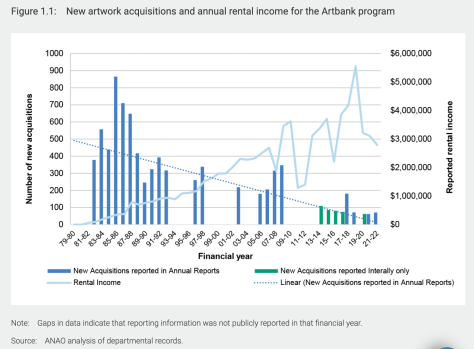
The federal government’s $42 million art collection and rental scheme has been criticised by the national audit office.

An ANAO report released last week looked at the government’s administration of the Artbank program, which has nearly 11,000 contemporary artworks available for lease to businesses, homes and overseas consulates.
Established in 1980, the program is meant to support Australian artists and promote their work to the public.
The collection has grown from 600 artworks to 10,950. In 2021 it reported revenue of $2.8 million, with 20 per cent of that ($566,000) spent on 71 new acquisitions.
In 2021-22, Artbank leased more than 4,350 artworks to 390 clients.
However the audit found the program’s administration by the Department of Infrastructure, Transport, Regional Development, Communications and the Arts leaves a lot to be desired.
“The department’s approach to acquiring, managing and leasing Australian contemporary art under the Artbank program has not been appropriate,” Auditor General Grant Hehir concludes.
Among the criticisms are:
- No overarching strategy to support the direction of the program or measure its success since it was established 40 years ago
- Acquisitions not in step with Commowealth procurement rules or the program’s targets
- No open or competitive process for aquiring artworks, no demonstration of value for money and limited public reporting
- Poor record keeping regarding the removal of works from the collection
- Failure to support artists in line with its objectives

Rental targets not being met
The audit found rental revenue has declined, with only about 40 per cent of the collection currently leased, compared to targets of 70 per cent.
Between 2015 and 29022 nearly 60 per cent of the collection wasn’t leased at all or spent most of its time in storage, which Mr Hehir says has meant less money to fund new acquisitions.
The effectiveness of Artbank in supporting artists has also progressively declined, with 179 acquisitions in 2016–17 dropping to 75 in 2021–22.
That’s meant the the amount of financial support for artists provided via the program has also been declining, with the $396,462 spent on acquisitions in 2021–22 compared to $507,993 spent in 2016–17.
Meanwhile, the governance committee established to oversee management and performance has only met three times since it was established in November 2019, and is yet to receive a report on the program’s financial performance, the audit found.
The program’s curatorial staff are responsible for identifying works from catalogues, submissions from artists and galleries, gallery visits, art fairs and festivals and art journals.
Artists have also been able to pitch their work to departmental officials during roadshow events, although these have “generated a declining number of applications each year”, from 40 in 2016 to just three in 2021.
Committed to improvement
In correspondence responding to the repot, the department notes that the program hasn’t been administered in accordance with Commonwealth procurement rules and says it’s committed to ensuring it achieves its objectives.
Secretary Jim Betts said the program played an important role in supporting emerging artists and making contemporary art accessible.
“The government is committed to the continuous improvement of the Artbank program, to ensure it continues to achieve its objectives,” he said.
Comment below to have your say on this story.
If you have a news story or tip-off, get in touch at editorial@governmentnews.com.au.
Sign up to the Government News newsletter